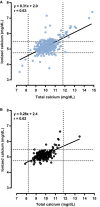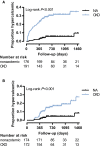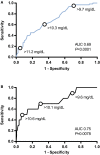Chronic Kidney Disease in Cats and the Risk of Total Hypercalcemia
- PMID: 28190275
- PMCID: PMC5354036
- DOI: 10.1111/jvim.14643
Chronic Kidney Disease in Cats and the Risk of Total Hypercalcemia
Abstract
Background: Chronic kidney disease (CKD) is a common comorbidity in cats with hypercalcemia, but whether CKD is a risk factor for hypercalcemia is unclear. Hypercalcemia often is diagnosed based on total calcium concentration (tCa), which tends to underestimate the ionized calcium concentration (iCa) in cats.
Objectives: Assessment of the performance of tCa for the diagnosis of ionized hypercalcemia, and exploration of factors influencing the relationship between iCa and tCa. Determination of risk factors for incident total hypercalcemia (ie, the development of hypercalcemia based on tCa during follow-up).
Animals: Records of a cross-section (n = 477) and observational cohort (n = 367) of client-owned cats with and without azotemic CKD from first opinion practice.
Methods: Retrospective cross-sectional and retrospective cohort study. The diagnostic accuracy of tCa as an index test for ionized hypercalcemia was evaluated, and risk factors for underestimation were explored by binary logistic and linear regression in a cross-section of cats with and without azotemic CKD. Chronic kidney disease and clinicopathological variables were assessed as predictors of incident total hypercalcemia by both time-invariant and time-dependent Cox regression in a cohort of cats.
Results: Specificity of tCa for identification of ionized hypercalcemia was high (100%), but sensitivity was low. Underestimation was associated with lower venous bicarbonate concentrations. Cats with CKD had increased risk for incident total hypercalcemia (hazard ratio, 4.29; 95% confidence interval, 1.96-9.37; P < .001). Higher tCa predicted incident total hypercalcemia in both azotemic and nonazotemic cats (P < .001).
Conclusions and clinical importance: Chronic kidney disease is a risk factor for incident total hypercalcemia, and most cats with increased tCa had concurrent ionized hypercalcemia. Higher baseline tCa predicts incident total hypercalcemia. Prospective studies assessing changes in iCa are warranted.
Keywords: Azotemia; Bicarbonate; Calcium; Feline.
Copyright © 2017 The Authors. Journal of Veterinary Internal Medicine published by Wiley Periodicals, Inc. on behalf of the American College of Veterinary Internal Medicine.
Figures



Similar articles
-
Ionized hypercalcemia in cats with azotemic chronic kidney disease (2012-2018).J Vet Intern Med. 2022 Jul;36(4):1312-1321. doi: 10.1111/jvim.16430. Epub 2022 May 24. J Vet Intern Med. 2022. PMID: 35608146 Free PMC article.
-
Calcitonin Response to Naturally Occurring Ionized Hypercalcemia in Cats with Chronic Kidney Disease.J Vet Intern Med. 2018 Mar;32(2):727-735. doi: 10.1111/jvim.15051. Epub 2018 Feb 22. J Vet Intern Med. 2018. PMID: 29469976 Free PMC article.
-
The effect of attenuating dietary phosphate restriction on blood ionized calcium concentrations in cats with chronic kidney disease and ionized hypercalcemia.J Vet Intern Med. 2021 Mar;35(2):997-1007. doi: 10.1111/jvim.16050. Epub 2021 Feb 1. J Vet Intern Med. 2021. PMID: 33527601 Free PMC article.
-
Update on Feline Ionized Hypercalcemia.Vet Clin North Am Small Anim Pract. 2017 Mar;47(2):273-292. doi: 10.1016/j.cvsm.2016.09.004. Epub 2016 Dec 14. Vet Clin North Am Small Anim Pract. 2017. PMID: 27988049 Review.
-
Calcium: total or ionized?Vet Clin North Am Small Anim Pract. 2008 May;38(3):497-502, ix. doi: 10.1016/j.cvsm.2008.01.010. Vet Clin North Am Small Anim Pract. 2008. PMID: 18402876 Review.
Cited by
-
Ionized hypercalcemia in 238 cats from a referral hospital population (2009-2019).J Vet Intern Med. 2023 Jan;37(1):80-91. doi: 10.1111/jvim.16627. Epub 2023 Jan 16. J Vet Intern Med. 2023. PMID: 36645022 Free PMC article.
-
Assessment of the association between diabetes mellitus and chronic kidney disease in adult cats.J Vet Intern Med. 2019 Sep;33(5):1921-1925. doi: 10.1111/jvim.15559. Epub 2019 Jul 15. J Vet Intern Med. 2019. PMID: 31305000 Free PMC article.
-
Acute on chronic kidney disease in cats: Etiology, clinical and clinicopathologic findings, prognostic markers, and outcome.J Vet Intern Med. 2020 Jul;34(4):1496-1506. doi: 10.1111/jvim.15808. Epub 2020 May 22. J Vet Intern Med. 2020. PMID: 32445217 Free PMC article.
-
Drp1 activates ROS/HIF-1α/EZH2 and triggers mitochondrial fragmentation to deteriorate hypercalcemia-associated neuronal injury in mouse model of chronic kidney disease.J Neuroinflammation. 2022 Sep 1;19(1):213. doi: 10.1186/s12974-022-02542-7. J Neuroinflammation. 2022. PMID: 36050772 Free PMC article.
-
Two-way Road of Kidney and Hypercalcemia: A Narrative Review.Cardiovasc Hematol Disord Drug Targets. 2023;22(4):200-206. doi: 10.2174/1871529X23666221205143041. Cardiovasc Hematol Disord Drug Targets. 2023. PMID: 36475333 Review.
References
-
- Barber PJ, Elliott J. Feline chronic renal failure: calcium homeostasis in 80 cases diagnosed between 1992 and 1995. J Small Anim Pract 1998;39:108–116. - PubMed
-
- Savary KC, Price GS, Vaden SL. Hypercalcemia in cats: a retrospective study of 71 cases (1991–1997). J Vet Intern Med 2000;14:184–189. - PubMed
-
- DiBartola SP, Rutgers HC, Zack PM, et al. Clinicopathologic findings associated with chronic renal disease in cats: 74 cases (1973–1984). J Am Vet Med Assoc 1987;190:1196–1202. - PubMed
-
- Midkiff AM, Chew DJ, Randolph JF, et al. Idiopathic hypercalcemia in cats. J Vet Intern Med 2000;14:619–626. - PubMed
-
- Lulich JP, Osborne CA, O'Brien TD, et al. Feline renal‐failure ‐ questions, answers, questions. Compend Contin Educ Vet 1992;14:127.
MeSH terms
Substances
LinkOut - more resources
Full Text Sources
Other Literature Sources
Medical
Miscellaneous

